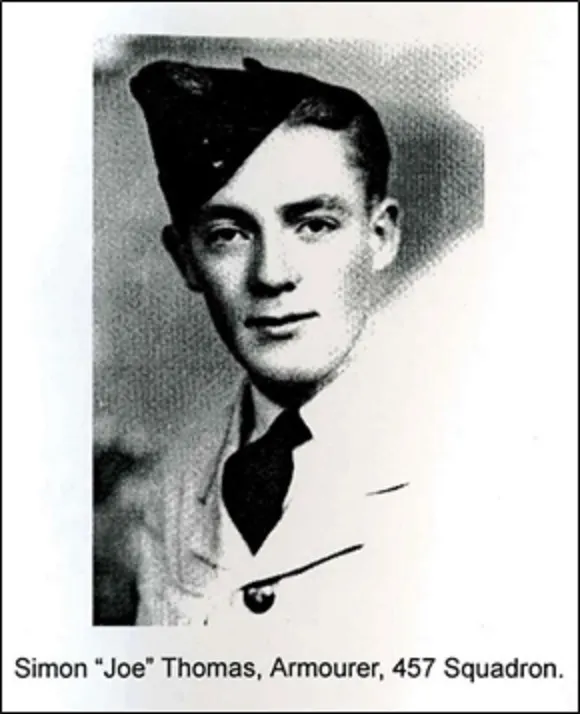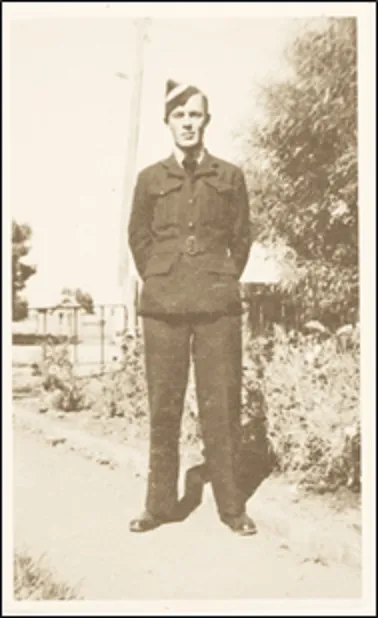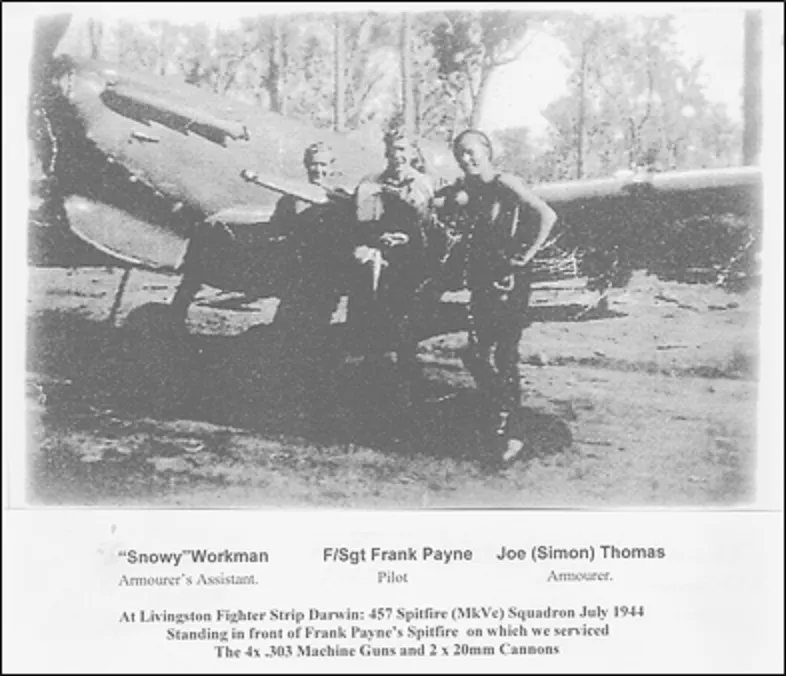LAC Simon Joseph Robin Thomas 430884



| Squadron/s | 457 SQN |
| Rank On Discharge/Death | Leading Aircraftman (LAC) |
| Nickname | Joe |
| Mustering / Specialisation | Armament Fitter |
| Date of Birth | 15 Feb 1925 |
| Date of Enlistment | 12 Apr 1943 |
| Contributing Author/s | Steve McGregor, Joe Thomas The Spitfire Association, Jan 2015 |
Joe, as he was known to his RAAF mates, was born on the 15th February, 1925 in Corowa, NSW and enlisted in the RAAF on the 12th April, 1943.
In his own words he reported as follows:-
I spent one year in the ATC (Air Training Corp) at Corowa, NSW before enlistment. Which I assume is the reason I never did a basic training course on enlistment.
I was accepted for Air Crew training in February 1943 and placed on reserve until inducted into No 1, ITS (Initial Training School) Somers (Vic) on 12th April 1943 to begin my Air crew training.
However, I did not complete the course and re-mustered to ground staff with a posting to No1 STT (School of Technical Training) Melbourne, billeted at the Exhibition Buildings, to be trained as a basic fitter at the Brunswick Technical School. After passing this course, which lasted three months, I was posted to No1 Armament School Hamilton, in Western Victoria.
This again was a three month course and on passing, I was posted to No 4 AD (Aircraft Depot), at Boulder, just outside Kalgoorlie, West Australia. This is where I worked on gun maintenance until being posted to No2 ED (Embarkation Depot), at the Melbourne Cricket ground in March 1944. From there I was posted to No 457 Spitfire Squadron, Darwin, arriving in April 1944, and camped at Livingstone Fighter strip.
A short while later, in August 1944, the Squadron moved camp to Sattler strip, where we converted to Mk VIII Spits. I was what you call an Armourer and we serviced and maintained the guns. Namely the .303 calibre Browning and the 20 mmm cannon. On each team we had about eight chums doing the work. The Squadron consisted of two wings namely 12 Spitfires in A flight and 12 in B flight, so we had a total of 24 aircraft in 457 Squadron.
In February 1945 the Squadron moved to Moratai Island, which is in the archipelago of the Dutch East Indies, now of course called Indonesia. In June 1945 the Squadron was transferred to Labuan Island, which is located off the North East Coast of Borneo.
The ground crews were transported via LCT's (Landing Craft Tanks). Anyone knowing the design of these ships would know there is not a lot of cabin space so I slept on deck. There were just not enough beds and cabins to go around.
However, if the truth be known I would say that I was quite happy to sleep on deck in the fresh air because I suffered from sea sickness. The LCT's were also loaded with stores and equipment to set up a base for operational service on Labuan.
Sometime later I was hospitalised in the SSQ (Station Sick Quarters) in August 1945 just after the second atomic bomb was dropped on Japan, subsequently I was repatriated to Heidelberg Repatriation Hospital (AGH) suffering from chronic Dermatitis. Now you may wonder how I contracted this condition and it was not the humidity. The doctors diagnosed the whole thing as due to blood poisoning from the carbon deposits which build up on the machine guns. Apparently I had cut my arm and the infection from the canon deposits entered there and eventually spread all over my body.
Anyhow I arrived there in mid-September 1945. As I said the atomic bomb had been dropped on Nagasaki and the nurse told me, while I was lying there, that everybody was going to soon celebrate the end of the war.
Would you believe it? I had then missed out on the celebration some time later and never had the chance to paint the town red.
In closing I must say that I liked doing what I did in the RAAF as an Armourer. I was lucky to be with a great bunch of guys. You know I never did get leave allocated to me because by the time I was due for leave the whole show was winding down and the powers that be must have thought it was pointless letting me go and having to get someone transferred from down south to do my job until I returned.
I was discharged from AGH on the 20th December and granted my first leave for nearly 2 years.
My posting to SSQ Laverton as an outpatient followed until I went before a Medical Board in late March 1946 and was declared PMU (Permanently Medically Unfit for service).
A little later I was discharged on 12/4/46 and returned home to Corowa.
In closing I must say that during my Squadron service I met and befriended some wonderful people, some who became life-long friends. One was then F/s Pilot Frank Payne, with whom I had regular contact, both verbally and physically up until his tragic death from Legionnaires Disease at the age of 80.
A photo of Frank with Snowy Workman and myself was taken at Livingston about July 1944. See photo.
In peacetime after the war I also worked for the same company as Ray "Boss" Hart for many years, see his biography on the Spitfire Association web site. Ray was with me in Darwin in 100 MFCU.

